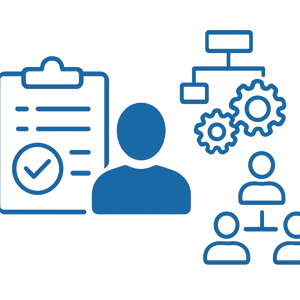innovations during the drug
discovery phase.
We take a personalized and integrated approach to help our clients position their pipelines and companies for success offering a full range of development and commercialization services.
We are Halloran, a life science consulting firm, partnering to enrich your product development and business growth. We propel your organization further; positively impacting the health and wellbeing of patients around the world.

When asked to the audience, “Do we need to rethink clinical operating models?” most of the audience responded with a resounding, “yes.” In the spirit of leaving legacy behind and ensuring patients and sites have the support and infrastructure needed to be successful, a group of expert panelists gathered to discuss Rethinking Clinical Operating Models: Moving from Ideas to Actions – a panel examining what should be kept, reinvented, or cut.
A lively discussion followed.
Leading the talk was Sheila Gwizdak, VP, Strategic Consulting Solutions at Halloran, and featuring the following panelists:
Whether you attended CORE or not, most people agree; clinical trials are expensive and take years to progress. With such high stakes in play and the prevalence of so many processes that are wildly inefficient, as an industry, we are overdue on restructuring how the right players are involved to enable a successful trial.
Sustain These Practices
Many processes, assumed necessary, simply do not propel development forward. While there are some things that you just can’t get around, like regulations, a panelist noted, even with regulations from health authorities, sometimes a no is a conditional yes. But this requires a deep understanding of those conditions and requirements to meet before being able to maneuver around or through them to push innovation forward.
In summary, here are the panelists’ responses on what to keep:
Practices to Adapt
Panelists were encouraged to share bold, provocative ideas, offering suggestions that may just land within some of the attendees’ organizations – a backbone of the event.
Building off earlier discussions from the day, especially the topic on Real-World Perspectives on Patient Recruitment and Engagement, suggestions included:
As a community, improvement happens when repeating mistakes isn’t made, and we collectively improve. A big statement. Yet, possible in little steps. Taking these considerations to heart, the question was posed, “how do we educate the community in a way that we advance together?”
Reinvent and Innovate
The panel discussion led to an interactive workshop, Trial Redesign Challenge: Turning Ideas into Blueprints, offering an opportunity for attendees to build off the feedback shared during the panel, meeting in five small groups around the following topics:
Representatives from each group shared their ideas to revamp each of these five topics, including what to keep, cut, and reinvent, enabling the panel to judge the ideas along a bold meter – truly, the spirit of CORE – rethinking, pushing boundaries, and sharing knowledge that is implementable.
Looking to enhance your clinical operating model? Halloran can help. Continue the conversation with us today.